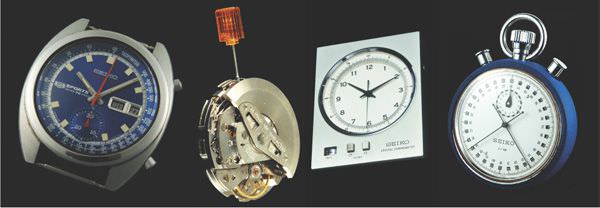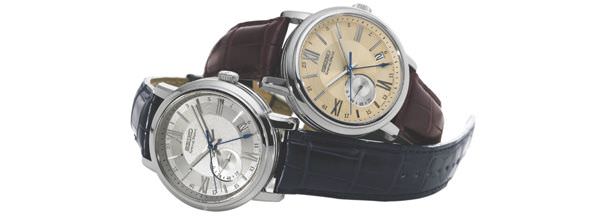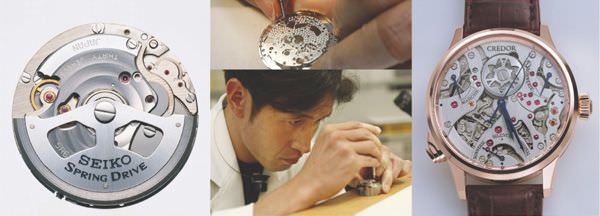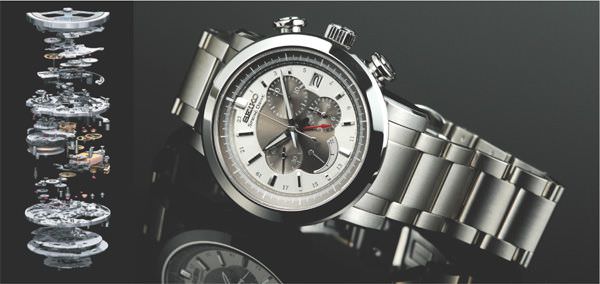Shiojiri, in the heart of the Japanese ‘Alps’, is not only a land of rice paddies, but also of vineyards and mountains. Ten watchmakers and engineers work here, in a highly concentrated environment, where the cream of Japanese watchmaking – Seiko’s Spring Drive Credor Sonnerie, Moon Phase and Skeleton watches – are developed, finished, and assembled.
This small atelier – the Micro Artist Studio located in one of the factories belonging to the Seiko Epson Watch Division – is the pride and joy of the Japanese company. It also employs only recognized and award-winning artisans. What they produce (only five Credor Sonneries – their most complex piece – are created each year) is only a drop in the ocean of the great Seiko-Epson empire, which produces 325 million movements and 16 million finished watches of all kinds per year. With 110,000 employees around the world, the Japanese company has a total turnover of 11 billion Euros.
But this prestigious ‘drop’ is capital from a strategic point of view. It is providing Seiko the means to move up to the summit of haute horlogerie and to demonstrate that the company is not simply a manufacturer of mass-produced timepieces. This important ‘drop’ is also the end result of a long journey that began in 1977. This 28-year voyage of research and development required infinite patience, persistence, and sometimes impossible effort, producing along the way 200 pages of pending patents and 600 prototypes. It culminated in the presentation of the first manual-winding Spring Drive watch at BaselWorld 1999.
So, what exactly is the Spring Drive?
Precision in the genes
It is a very long story. It all began in 1881 when the founder of the empire, Kintaro Hattori, opened a watch atelier. In 1892, he began making wall clocks and gave his company the name Seiko, which means ‘precision’ in Japanese. Hattori’s quest for precision would leave an indelible mark on the firm. Precision makes up a major part of Seiko’s fundamental gene pool.
Very rapidly, Kintaro Hattori’s clocks and his pocket watches (starting in 1895) acquired a reputation precisely for their precision, which allowed the company to overtake its compe-tition, and become solidly entrenched in the landscape. The success of Seiko was due notably to the early verticalization of its production, which allowed the brand to have strict control over the quality of its products. In 1904, for example, Seiko developed its own machines to create pinions and, in 1913, the first wristwatch created in Japan rolled out of its factories.
This search for precision would also continue. In 1956, Seiko produced its first entirely original manual-winding mechanical movement (the Calibre 55), conceived and designed by its own engineers and watch-makers, who looked within for inspiration, without drawing on what was happening at that time in Switzerland and the USA. With this timepiece, the firm won the Precision Competition in Japan. Building upon its Calibre 55 as a base, Seiko introduced its first automatic movement in 1959, Gyro-Marvel, equipped with a ‘magic lever’ permitting the movement to be wound in both directions.
The following year, Seiko presented its first Grand Seiko – also the name of its prestige collection – a chronometer that was certified according to standards stricter than those of the COSC. Encouraged by its performance, Seiko’s watchmakers decided to enter the watch in the famous Swiss Observatory Competition. They participated for the first time in 1964 “with ter-rible results”, as the watchmakers now say with humour and humility. But they did not give up, and in 1968, their watches surpassed the results of the Swiss watchmakers. In 1969, Seiko launched its Calibre 6139, the first automatic chronograph, at exactly the same time as Zenith, Breitling, Büren, and Heuer launched theirs.

Shiojiri Epson building, Kintaro Hattori, the first japanese wristwatch, Chronometer 1968
The world’s first quartz wristwatch
In parallel, and still in search of precision, Seiko worked relentlessly to create the first quartz watch. It came out the same year, in 1969, under the name of Astron. It was a world first, and the beginning of a revolution that would shake the entire watch industry to its foundations.
Seiko had been working on this calibre during the previous decade, seeking to miniaturize a movement that, in 1959, occupied a space of two metres by one metre. Four years later, in 1963, the calibre had been reduced to fit into a table clock called the Crystal Chronometer, which would earn Seiko the honour of being appointed as the timer for the Olympic Games in Tokyo in 1964.
To attain this important milestone, the Japanese watchmakers had to completely develop, in-house, the necessary electronic technology and savoir-faire, which would later prove to give them a decisive advantage. Three major inventions coming out of Seiko’s ateliers would forever change the face of timekeeping: the system of the step motor that offered superior energy and a year of power; its division in different locations of the movement and the quartz oscillator in form of a diapason. (These inventions, of which Seiko has released the patent rights to all manufacturers, are still used in 100 percent of the quartz movements produced around the world today.)

First Automatic Chronograph 1969, Calibre 6139, Crystal Chronometer, Stopwatch 1964
Combining quartz and automation
“Once the quartz wristwatch was invented and realized, it was its power source, the battery, that became the centre of our preoccupations,” explains Osamu Takahashi, one of the many Seiko spokespeople. The battery became even more important because, with the widespread use of quartz, consumers began owning several watches. This meant that they needed to function for the longest duration possible in order to be available at all times. In addition, the import-ance of environmental concerns soon also became evident.
With these considerations in mind, Seiko’s watchmakers decided to try and generate energy using a rotor. They initiated a project that would result in the creation of the Kinetic in 1988. This technology (named AGS for Automatic Generated System, until 1992) used a rotor to create the required energy, which would then be stored in an accumulator, thus eliminating the battery. Following its resounding success in both Japanese and international markets, Seiko deepened its research into the purely mechanical aspects of the watch. The goal was to combine the best of both worlds – the pre-cision of quartz with the beauty of the tra-ditional mechanical timepiece. From this desire was born the Spring Drive, a mechanical watch in which the traditional escapement was replaced by an electronic escapement. The result is a level of precision unattainable up to now for a mechanical watch, of the order of ± 1 second per day or 15 seconds per month. Its increased power reserve, at least 72 hours, is a 30 percent improvement over normal automatic winding. Its glide motion, or continuous gliding of the hands, is symbolic of the passage of time.

SPRING DRIVE
The genesis of an idea
But let’s turn back the clock a few years. It was in 1977 that the idea of a ‘mecatronic’ watch first came to Yoshikazu Akahane, then a young engineer at Seiko Epson. A physicist by training, Akahane pondered a mechanism comparable to that of a bicycle that could travel down a slope at constant speed, without accelerating, as if braked by its wheel-driven dynamo.
But this idea was not in the official research programme of the company. Akahane thus demanded that a young engineer, Takehide Yamada, work on the project outside of normal hours. Theoretically, the idea seemed workable, but the question was how to make it happen. Using the mechanical Calibre 63, Yamada designed bobbins (equivalent to the dynamo of a bicycle) but he did not yet know how to brake them (except by hooking and unhooking the two electrical wires attached to them).

ASTRON 1969, KINETIC AGS, Yoshikazu Akahane, ‘sketch’
In this way, Akahane and Yamada succeeded in obtaining four hours of power reserve, or 10 percent of their goal. Based on their progress, the research project was made official in 1983. Over the course of a year, the two men collab-orated with the Institute of Industrial Science at the University of Tokyo. Nearly losing their health in the process, they still were not able to find the miracle dynamo that could generate enough energy to provide the required power reserve. The project was suspended in 1984.
Second phase
In the meantime, the research being conducted on the Kinetic forced Seiko to work vigorously on reducing energy consumption. When the Japanese engineers finally succeeded, this gave them renewed confidence in the feasibility of the Spring Drive, and the project was started again. Osamu Takahashi, one of the managers during this second phase, explains that they explored several avenues. Using the ultra-performing generator developed for the Kinetic, they laboured to find the ideal combination for the main gear train, and deepened their efforts in the nature of the spring itself, developing a new alloy called Spron 510, with improved elasticity.
In 1993, they came out with a new generation of prototypes that were able to maintain a power reserve of 10 hours. This was, however, still not enough. By using two bobbins, one with a winding of 77,000 turns, and the other with 23,000 turns – which was impossible to reproduce on an industrial scale – they were, however, able to obtain a power reserve of 42 hours for a movement that was still not commercially viable. Once again, the project came to a halt.

Prototype 1982, Prototype 1993, Manual wounded Prototype 1998
Third phase
In 1997, it was restarted “only because its creator, Akahane, wanted it”. (Akahane had become CEO of the Watch Division in the meantime, but unfortunately he passed away before seeing his dream realized.) Electronics experts now joined the research efforts. The purely mechanical part of the equation posed no real problems so the engineers gave priority attention to the integrated circuits. At that time, Seiko Epson had circuits with low energy consumption that were developed for the Kinetic and solar watches, but the problem was still difficult because, lacking equilibrium between the production of energy and what was needed to ‘brake’ the movement, the device was still considered a ‘suicidal machine’.
Two solutions were possible, explains Kunio Koike, in charge of the third phase. They could either increase the generation of energy or lower even more the consumption of the integrated circuit. To achieve the desired balance of forces, Seiko developed a special, new-gener-ation integrated circuit (functioning at 0.5V, or half that of a conventional low-energy chip). In parallel, the company created a new type of stator made of only one part, in permalloy, while also improving the winding techniques.
Finally, Seiko’s engineers saw the light at the end of the tunnel. In 1997, they sent an official communication describing their results to the Swiss Society of Chronometry. (As an aside… at the same time, a nearly identical submission came from Assulab/Swatch Group, whose HPM [High Precision Mechanism] movement model was never released, undoubtedly due to the problems associated with a generator that was too heavy to be inserted into a wristwatch, or because of the lack of equilibrium between the production and consummation of energy.) Seiko’s first prototype was presented at the Basel fair in 1998, and in 1999, their first manual-winding Spring Drive was launched.
Moving towards haute horlogerie
From there, ‘The Quiet Revolution’, as Seiko likes to call it, began to take off in earnest. The first Spring Drive automatic was presented in 2005; the acclaimed Spring Drive Sonnerie in 2006; and the Spring Drive Chronograph in 2007.
With the technical problems solved, the watchmakers at Seiko began concentrating on design, finishing, and other details that make this collection not only an innovative technical line but also a family of timekeepers that have earned a place in the domain of haute horlogerie.
Produced 100 percent by Seiko Epson, the Spring Drive timepieces are assembled by specially trained watchmakers in two distinct and highly specialized ateliers, the Takumi (Mastery) Studio and the Micro Artist Studio.
Around 15 watchmakers work at the Takumi Studio, of which nine are dedicated solely to the Spring Drive. Their task is to assemble the Spring Drive automatics and chronographs. Here, there is no division of labour. Each watchmaker, on his own individual workbench in an atmosphere of an almost all white room, assembles the 280 mechanical component parts and the ten electronic parts of each movement, from A to Z, producing five to six finished pieces per day. While current production is a few thousand pieces per year, the stated objective of Shinji Hattori, CEO of the Watch Division and member of the founding family, is to attain the level of 20,000 pieces per year over the next ten years. (We note in passing that if the Swiss are finding it difficult to recruit competent watchmakers, this problem is even more critical in Japan.)
The Micro Artist Studio has eight watchmakers and engineers, all working on the most pres-tigious pieces. In this studio, new products are developed; each component part is hand-finished – chamfered, polished, decorated (under the benevolent photograph of Philippe Dufour, considered here as a veritable ‘living treasure’ who has carefully advised them); each watch is assembled from parts produced entirely in-house (right down to the cut, the polishing of the markers and the hands, as well as the dials, screws, etc.). With the quality of work that comes out of the Micro Artist Studio, the watchmakers have no reason to envy even the most beautiful pieces of Swiss craftsmanship.

First automatic movement, Takumi Studio, CREDOR SPRING DRIVE SONNERIE
The singular Japanese approach
One example of this quality is the Spring Drive Credor Sonnerie, which perhaps epitomizes not only the best quality but also the most original approach to timekeeping. Without returning in detail to this piece which was presented earlier (see ‘The Credor Spring Drive Sonnerie opens new horizons in haute horlogerie’ in Europa Star, August-September 2006, or online at www.europastar.com), let’s highlight two major elements: the incredible originality of its chime and the aesthetic quality of its execution.
In place of a traditional bell, this chime mechanism has a true bell in the shape of a plate, cast in a secret alloy of copper, which is integrated into the lower part of the movement. The bell is struck from the interior by a hammer driven by a silent governor, which is activated by the viscosity of the air, thus avoiding any mechanical noise in triggering the bell. The sound is thus produced in complete silence and resonates for a relatively long time (five to seven seconds). It reminds the listener of a Buddhist temple bell. “I wanted to create a movement that speaks of serenity and calm,” explains Matasohi Moteki, the movement’s designer.
This ‘Japaneseness’ is also found in the design details of the movement and case which express “the nature of its area of origin”, says Testsuo Okaya. The open areas between the bridges evoke the currents of a river; the cut-out design of the barrel represents a flower from the Shiojiri region; the deliberately different-sized jewels are disseminated like flowers in the fields. All these details bear witness to the extreme attention given to the piece’s finishing, quality, and originality. Of a more technical nature, another detail includes the cut-out areas in the case back, which serve to enhance the resonance of the bell’s chime. The area is protected from moisture with a thin metal filter pierced, by erosion, with 502-micron holes.
We could also make similar observations about the Spring Drive Chronograph, but space is unfortunately lacking. (For those interested in this watch, see our article in the April-May 2007 edition of Europa Star or online at www.europastar.com.)

SPRING DRIVE CHRONOGRAPH
Precision and ‘soul’
Towards the end of our visit with the watchmakers of Seiko, and very impressed by the creations and the quality that we encountered, we nonetheless dared to ask the question: By removing the heart and the escapement from the mechanical watch, aren’t you also taking away a little bit of its soul?
The answer was faithful to what Seiko is ‘genetically’ and reflects its objectives since the very beginning: precision, the total pursuit of precision. In this case, precision is expressed with a movement that glides perfectly with its hands, which Seiko calls “a natural precision”. After all, isn’t precision the ultimate goal of all watchmakers worthy of the name?
When this quest for precision brings together, as in the Spring Drive, the search for beauty and quality, with the love for craftsmanship and innovative technical solutions, we cannot find any reason to object to the path Seiko has chosen.
Even more, time waits for no one. It is always moving towards the future. One of the futures of watchmaking is perfectly embodied by the Spring Drive, which for the first time, offers a real alternative, a very Japanese alternative, to prestigious Swiss timekeeping.
How the Spring Drive Automatic watch functions
The Spring Drive is an automatic mechanical watch whose regulating organ is no longer the traditional escapement but has been replaced by an electronic regulator.

1 - The energy is supplied by a traditional oscillating weight that winds a new-generation mainspring (Spron 510), which assures a power reserve of 72 hours and a very balanced transmission of its energy.
2 - This energy is transmitted to the gear train by a mechanical system called a ‘magic lever’ that operates in only one direction (counter clockwise) using two hands. These alternately pull and push an intermediate gear, thus improving the regularity and duration of the transmission by about 30 percent as compared to traditional transmission systems. The final gear in the gear train is a rotor, called a ‘glide wheel’ that powers a fixed bobbin.
3 - The transmission of energy, passing by the glide wheel is controlled by the ‘Tri-Synchro Regulator’. This regulator is composed of the bobbin (or an electric generator), an integrated circuit, and a quartz oscillator. The bobbin electrically powers the quartz oscillator that delivers signals to the integrated circuit, which in turn regulates the electromagnetic braking of the glide wheel. The glide wheel rotates eight times per second (the equivalent of a traditional escapement of 28,800 vibrations per hour). The hands are braked rather than propelled, and move smoothly, gliding around the dial of the watch. The precision attained is ± 15 seconds per month.
Source: Europa Star October-November 2007 Magazine Issue








